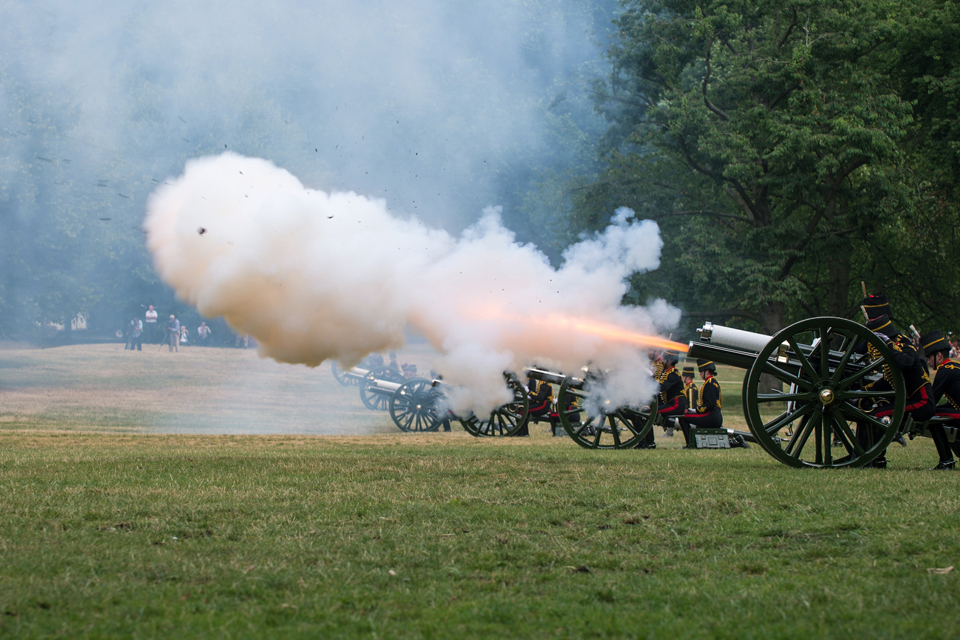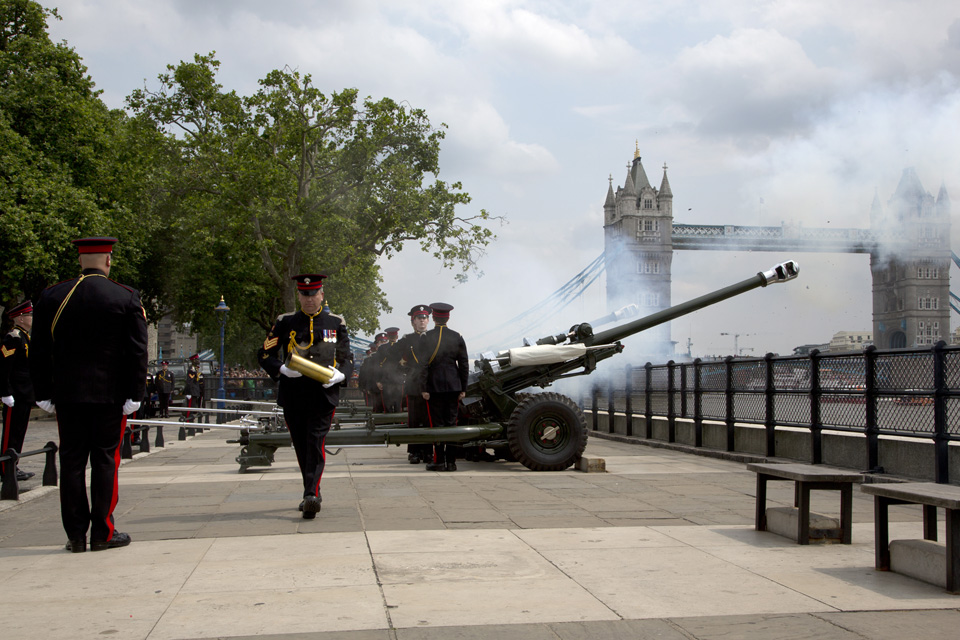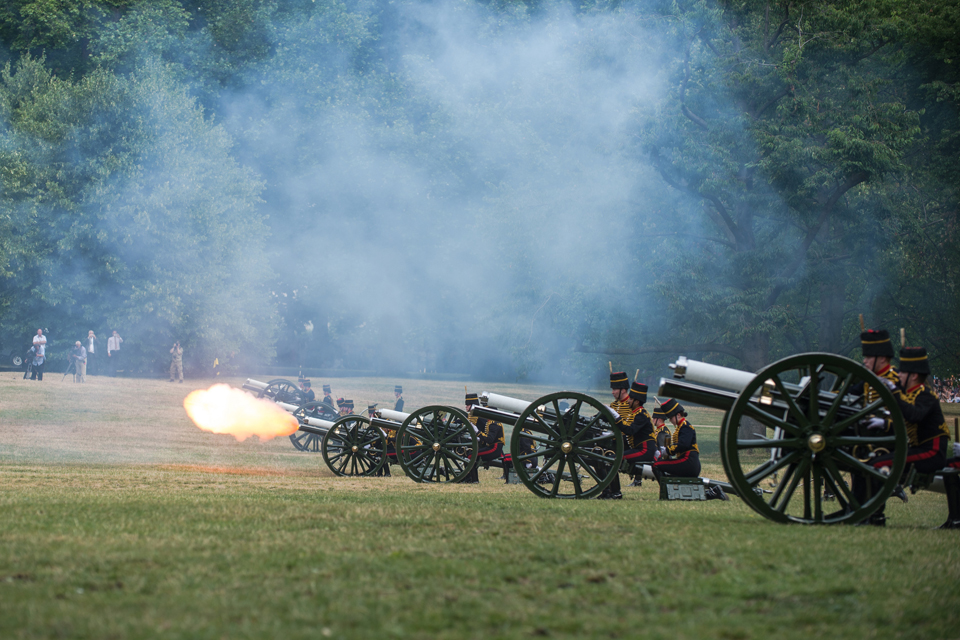British soldiers have officially welcomed the royal baby into the world today with volleys of gunfire across the capital.
The King’s Troop Royal Horse Artillery (RHA), wearing immaculately presented full dress uniform, rode their horses and First World War gun carriages past Buckingham Palace today to Green Park, where they staged a 41-gun salute to mark the birth of the new royal baby.
The soldiers, horses and guns of The King’s Troop rode out from their forward mounting base in Wellington Barracks and made their way to Green Park. The guns are the Regiment’s Colours and so were afforded due respect throughout the route.
71 horses pulling 6 First World War-era 13-pounder field guns dramatically came into action from the north of the park to place the guns into position for the royal salute. The commanding officer was Major Mark Edward RHA, and the parade commander was Captain John Cockburn, the Troop Captain.
On the word of command, each of the 6 guns fired blank artillery rounds at 10-second intervals until 41 shots were fired. The horses and riders then collected the guns and escorted them back to Wellington Barracks in Birdcage Walk.
At the same time, the Honourable Artillery Company (HAC), the City of London’s Army Reserve regiment, fired a gun salute from Gun Wharf at the Tower of London. The HAC provided 3 ceremonial 105mm light guns, similar to those currently used in Afghanistan, and fired a 62-gun royal salute.
The soldiers were drawn from across the Regiment and the battery commander was Major Danny Daniels HAC. At the stroke of the hour, 62 rounds were fired at 10-second intervals.
Whilst a royal gun salute normally comprises 21 guns, this is increased to 41 if fired from a royal park or residence. Uniquely, at the Tower of London, which is a royal residence, a total of 62 rounds are fired on royal occasions as this also includes an additional 21 guns for the citizens of the City of London to show their loyalty to the monarch.
Although today’s royal salute for the Duke and Duchess of Cambridge’s first child has a certain resonance - this baby could one day become the future ruler of Great Britain and Head of the Commonwealth - the custom is that gun salutes are fired for the birth of every prince or princess, no matter where their place is within the succession. The last royal salute for a royal birth was for Princess Eugenie in 1990.
A 21-gun salute was also fired today by Headquarter Company (Thompson’s Battery) of the Royal Gibraltar Regiment to mark the birth of the Duke and Duchess of Cambridge’s son, and similar salutes occurred in other Commonwealth countries including New Zealand, Canada and Bermuda.
How many Miscarriages of Justice has Stephen Beattie Created?
Investigation of Cleveland/Staffordshire Police Scene of Crime Officer
[Stephen Beattie, who worked for Staffordshire Police from 1996 to 2002, was arrested on suspicion of perverting the course of justice in May 2011 and remains on bail]
The Independent Police Complaints Commission's investigation into concerns about the quality of work and qualifications of a 49-year-old man who worked as a scenes of crime officer is continuing.
The investigation, which began in February 2011, covers a time period from 1996 to 2011. The man worked for Staffordshire Police from 1996 to 2002, Northumbria Police for a short period in 2002 and Cleveland Police from 2002 to 2011. Major Incident Teams at Staffordshire and Cleveland Police have been working on the investigation, under the direction and control of an IPCC investigator. Northumbria Police worked with the IPCC to confirm that there were no concerns over the man's work during his short employment with them.
The man was arrested on suspicion of perverting the course of justice in May 2011 and remains on bail. He was suspended from duty by Cleveland Police in February 2011 and resigned in October 2011.
The managed investigation is examining allegations that the man conducted sub-standard work, potentially undermining investigations into a range of incidents including suspicious deaths, and had lied about his qualifications when involved in arson investigations.
So far:
* Cleveland Police identified 141 cases involving suspicious deaths which required review. So far reviews of 90 have been completed. This review has highlighted eight cases where the alleged failings of the officer could have had an impact. As a result further work has been or is being undertaken around those cases.
* Cleveland Police identified 141 cases involving suspicious deaths which required review. So far reviews of 90 have been completed. This review has highlighted eight cases where the alleged failings of the officer could have had an impact. As a result further work has been or is being undertaken around those cases.
* Cleveland Police has also undertaken a review of all arsons attended by the officer - 214 cases. Sixteen of those cases are now with the Crown Prosecution Service for consideration of potential prosecution or referral to the Criminal Cases Review Commission.
* Cleveland Police is undertaking a review of all exhibits handled by the officer - 3308 cases reviewed. These have been graded into Red, Amber and Green categories. There are approximately 480 cases in the red category, ie those causing the most concern, for example where the officer has handled exhibits in cases involving convictions and where there is a possibility he may have compromised the integrity of the case. A full review of all these cases is to be undertaken.
* Staffordshire Police has reviewed 1570 scenes of crime report forms completed by the officer. Of these 32 were found to require further analysis.
* The investigation is also examining the supervision of the officer during his time with the two forces.
IPCC Commissioner Cindy Butts said: "This remains a complex investigation covering a period of 15 years and a significant number of cases. The examination of those cases is ongoing but is a huge task and will take several more months. The most significant cases have been prioritised and any additional work identified has been acted on immediately. Cleveland Police have ensured that families affected by these cases have been kept informed.
"As this remains a criminal investigation we do not intend to go into specific detail about cases at this stage."
-




